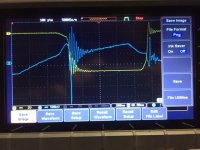Hello,
The layout cannot be improved I don't think. I have high side transistors sticking up, low side transistors sticking down with the d/s legs of high and low soldiered together with the copper phase connection coming off. They are only about 8mm apart. The bus + and - is only separated with the inner circuit board, with copper plate running to all the FET legs. I have over 100 x 22uf polymer caps with 2.2A ripple current each. The two models below are a similar design, I don't have the final ones to hand as I am at work. The bus connections are not on, they are a stud in the center with + on the top side and - on the bottom.
This is my third attempt and I believe I have optimised the layout as much as possible.
The gate drivers are plugged in around the outsides with the main control board plugged on the end.
I have increased the turn on resistors to 75R (originally 18R) to try and slow the switch. The gate drivers are high output and the FET's have a low gate charge which I think has lead to the very high gate resistor value. Switch off is on 8R resistors.
I am not sure how the spike will increase with current, as I have not yet pushed it. If it doesnt get much worse I am not to bothered. Its just if it starts getting alot bigger with more current.
I have not really allocated any space for snubbers as I wanted to avoid, I am considering removing a FET from each phase and replacing with a sckotty diode as I feel it might help route the spike back to the bus providing there is enough time for it to conduct. I could maybe place a snubber across the low side, I believe this is where it needs to be to help with the high side switch on, but this would be one for all the FET's not one per FET. I did wonder if there was some way of using a TVS diode to clamp the spike back to +, but I cant see how this would be possible.
I could try more gate resistance, as I feel the switch on is still quite fast? but then I am not sure what a normal switch on time is. I am current running at 100kHz, but I could reduce this, the idea was the high frequency would help with the spikes.
I will also tune the deadtime between high and low side complimentary switching, but I am not sure what amount of deadtime I should aim for, would 300ns be reasonable?
View attachment 1


